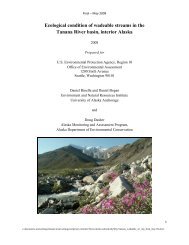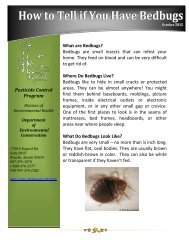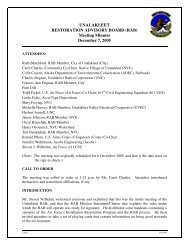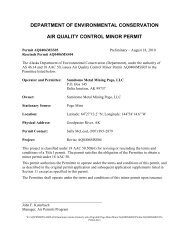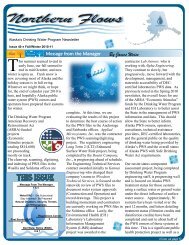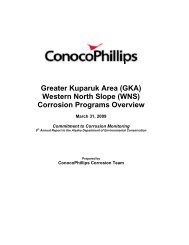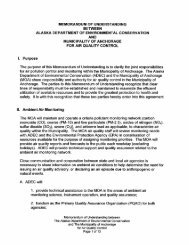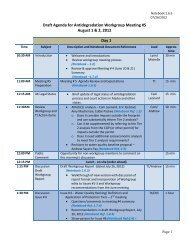2012 Ocean Ranger Guidebook Revision 3-7-12 - Alaska ...
2012 Ocean Ranger Guidebook Revision 3-7-12 - Alaska ...
2012 Ocean Ranger Guidebook Revision 3-7-12 - Alaska ...
Create successful ePaper yourself
Turn your PDF publications into a flip-book with our unique Google optimized e-Paper software.
<strong>20<strong>12</strong></strong> <strong>Ocean</strong> <strong>Ranger</strong> <strong>Guidebook</strong> 3-7-<strong>12</strong><br />
cruise ships to dispose of food wastes in <strong>Alaska</strong> as long as it is coming from US or Canadian ports and the<br />
ship does not carry prohibited or restricted products. If APHIS items are offloaded they must be<br />
separated from the regular waste offloads.<br />
Note- not many ships offload food products in <strong>Alaska</strong>. They do not use foreign foods or incinerate these<br />
wastes. If it is done report in the daily report waste information section.<br />
What to check for: Check for comingling of food preparation or food wastes with garbage. Check that<br />
offloads are leak-proof and covered. Check for labeling and documentation of the food wastes.<br />
Citations:<br />
9 CFR 94.5 Regulation of certain garbage. (Aircraft and Hawaii requirements removed)<br />
(a) General restrictions —(1) Interstate movements of garbage from Hawaii and U.S. territories and possessions to the continental United<br />
States. Hawaii, Puerto Rico, American Samoa, the Commonwealth of the Northern Mariana Islands, the Federated States of Micronesia,<br />
Guam, the U.S. Virgin Islands, Republic of the Marshall Islands, and the Republic of Palau are hereby quarantined, and the movement of<br />
garbage therefrom to any other State is hereby prohibited except as provided in this section in order to prevent the introduction and spread of<br />
exotic plant pests and diseases.<br />
(2) Imports of garbage. In order to protect against the introduction of exotic animal and plant pests, the importation of garbage from all foreign<br />
countries except Canada is prohibited except as provided in paragraph (c)(2) of this section.<br />
(b) Definitions — Agricultural waste. Byproducts generated by the rearing of animals and the production and harvest of crops or trees. Animal<br />
waste, a large component of agricultural waste, includes waste (e.g., feed waste, bedding and litter, and feedlot and paddock runoff) from<br />
livestock, dairy, and other animal-related agricultural and farming practices.<br />
Approved facility. A facility approved by the Administrator, Animal and Plant Health Inspection Service, upon his determination that it has<br />
equipment and uses procedures that are adequate to prevent the dissemination of plant pests and livestock or poultry diseases, and that it is<br />
certified by an appropriate Government official as currently complying with the applicable laws for environmental protection.<br />
Approved sewage system. A sewage system approved by the Administrator, Animal and Plant Health Inspection Service, upon his<br />
determination that the system is designed and operated in such a way as to preclude the discharge of sewage effluents onto land surfaces or<br />
into lagoons or other stationary waters, and otherwise is adequate to prevent the dissemination of plant pests and livestock or poultry<br />
diseases, and that is certified by an appropriate Government official as currently complying with the applicable laws for environmental<br />
protection.<br />
Carrier. The principal operator of a means of conveyance.<br />
Continental United States. The 49 States located on the continent of North America and the District of Columbia.<br />
Garbage. All waste material that is derived in whole or in part from fruits, vegetables, meats, or other plant or animal (including poultry)<br />
material, and other refuse of any character whatsoever that has been associated with any such material.<br />
Incineration. To reduce garbage to ash by burning.<br />
Inspector. A properly identified employee of the U.S. Department of Agriculture or other person authorized by the Department to enforce the<br />
provisions of applicable statutes, quarantines, and regulations.<br />
Interstate . From one State into or through any other State.<br />
Person. Any individual, corporation, company, association, firm, partnership, society, or joint stock company.<br />
Shelf-stable. The condition achieved in a product, by application of heat, alone or in combination with other ingredients and/or other<br />
treatments, of being rendered free of microorganisms capable of growing in the product under nonrefrigerated conditions (over 50 °F or 10<br />
°C).<br />
Sterilization. Cooking garbage at an internal temperature of 2<strong>12</strong> °F for 30 minutes.<br />
Stores. The food, supplies, and other provisions carried for the day-to-day operation of a conveyance and the care and feeding of its<br />
operators.<br />
Yard waste. Solid waste composed predominantly of grass clippings, leaves, twigs, branches, and other garden refuse.<br />
(c) Garbage generated onboard a conveyance —(1) Applicability. This section applies to garbage generated onboard any means of<br />
conveyance during international or interstate movements as provided in this section and includes food scraps, table refuse, galley refuse,<br />
food wrappers or packaging materials, and other waste material from stores, food preparation areas, passengers' or crews' quarters, dining<br />
rooms, or any other areas on the means of conveyance. This section also applies to meals and other food that were available for<br />
consumption by passengers and crew on an aircraft but were not consumed.<br />
(i) Not all garbage generated onboard a means of conveyance is regulated for the purposes of this section. Garbage regulated for the<br />
purposes of this section is defined as ―regu lated garbage‖ in paragraphs (c)(2) and (c)(3) of this section.<br />
(ii) Garbage that is commingled with regulated garbage is also regulated garbage.<br />
(2) Garbage regulated because of movements outside the United States or Canada. For purposes of this section, garbage on or removed<br />
from a means of conveyance is regulated garbage, if, when the garbage is on or removed from the means of conveyance, the means of<br />
conveyance has been in any port outside the United States and Canada within the previous 2-year period. There are, however, two<br />
exceptions to this provision. These exceptions are as follows:<br />
102






